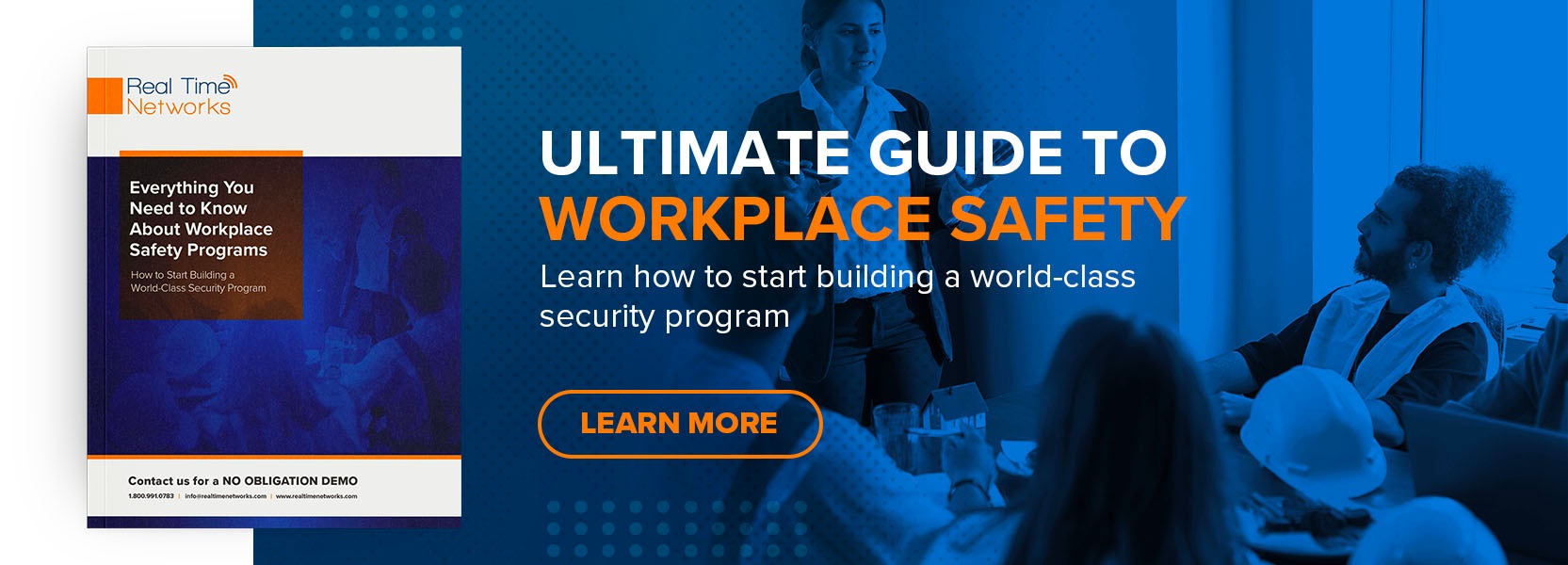By Jay Palter | August 13, 2020

There are too many health and safety challenges in the workplace for individuals to fend for themselves. That’s why every major developed nation has an agency tasked with establishing workplace health, safety, and security regulations.
Good safety regulations encourage both workers and employers to protect each other’s well-being and financial health. It takes mutual effort to keep everyone safe and productive.
Why are health, safety, and security important in the workplace? Because every business benefits from caring about them.
Top Workplace Health, Safety, and Security Concerns
Preventing illness, injuries, and crime will always be a challenge for businesses. Your exact priorities will change if there’s a disease outbreak or if new, unfamiliar technology increases certain kinds of injury, but those general concerns remain.
Businesses should be more concerned about security/safety staff getting spread too thin. Risks and associated regulations are evolving at a rapid pace. Financial constraints are forcing many businesses to downsize, leaving too few staff with too many health and safety tasks.
We need to find solutions that automate health and safety tasks. We need to take a comprehensive approach to health, safety, and security in the workplace.
The Business Case for Workplace Health & Safety
Workplace health, safety, and security programs improve quality of life for your employees, but they also improve your business’s bottom line. Liberty Mutual Insurance maintains a public Workplace Safety Index, last updated in 2018, where they track injury trends. They found that nonfatal workplace injuries caused nearly $60 billion in direct U.S. worker compensation costs that year.
That’s just injuries. The business case for managing employee health is even stronger.
U.S. businesses lose over 1.4 billion work days of productivity annually due to “absence and impaired performance,” according to the Integrated Benefits Institute (IBI), which IBI estimates is roughly equivalent to $500 billion annually. Keeping your employees healthy and at work isn’t just the right thing to do, it can also drastically improve your bottom line.
3 Reasons Physical Security Is Important
Physical security is sometimes overlooked by businesses, especially in favor of cybersecurity, but there are many reasons it’s still important:
1. Physical Security Protects Your Property
Like with protecting worker health and safety, there is a strong business case for physical security. Bad actors on staff are able to identify from the inside where security is lacking. Because of that, U.S. companies lose on average $1.13 million annually to employee theft.
2. It Protects Intellectual Property
When your business data is moving around on phones, tablets, and laptops, you need more than cybersecurity to keep your intellectual property and trade secrets safe. You need to secure those devices and the physical spaces where they’re stored.
3. It Improves Staff Well-Being
Happy staff are productive staff. When they know they’re working in a secure environment, it’s much easier for them to focus on work. They won’t be distracted by perceived threats to themselves or their workplace.
3 Reasons Health and Safety Are Important
There are many good reasons to protect the health and safety of your employees. They are the engine that drives your business. If you want to get the most from your employees, you need to invest in their well-being.
1. Prevent Illness and Injury, Even Death
No one wants to see the people they work with get sick or injured. Preventing illness and injury is a natural priority for any business leader. Health and safety programs, such as temperature screenings, are an excellent way to prevent the spread of illness.
Training programs are your most important tool here. Because no two businesses are the same, employees need to be trained to understand the unique risks of illness or injury that they might face in your facility.
Good technology also has its place in preventing injuries and death. It can be a vital tool for protecting employees when they need to work alone or in isolated environments.
2. Fewer Illnesses and Injuries Increase Productivity
Beyond a desire to protect the people you work with, reducing illness and injuries also protects your business. You can reduce or eliminate direct compensation costs and indirect costs of lost productivity.
Businesses are required to carry workers’ compensation insurance in almost every U.S. state. High injury rates in your workplace will increase insurance premiums. And if a business is underinsured for major claims, the gap in coverage is usually borne by the business.
Then there are the indirect costs of lost productivity. In some sectors, such as in construction or manufacturing, certain injuries require investigations that shut down operations until they’re complete.
Unsafe working environments can also lower employee morale and cause employees to be distracted if they’re concerned about their safety. If they have to be focused on their personal safety, they can’t focus on work. Training and good emergency preparedness will help them feel safe and keep them focused on the task in front of them.
3. Manage Public Relations and Liability
Good safety programs can improve the public’s perception of your business and help you attract top talent. Demonstrating that you can competently manage incidents in the workplace will speak to your ability to manage your business relationships. Just as a retail customer wouldn’t want to walk into a cluttered store full of rickety shelves and dangerously balanced goods, B2B customers might be wary of signing a contract with an organization that they perceive to have an “anything goes” attitude about safety. Prioritizing health and safety programs that help your employees care for their mental and physical well being also demonstrates that you value your people. When candidates and employees feel valued, they’re more likely to sign or stay with a company over the long term.
Good health and safety programs can also reduce employer liability for wrongful death and other civil suits. OSHA estimates that since 1971, when it was founded and began mandating basic workplace health and safety programs, U.S. workplace fatalities and civil suits have been cut in half. And this while the labor pool nearly doubled.
What You Can Do
Those are just some of the reasons why health, safety, and security are important in the workplace. So what can you do to prioritize them at your business?
Lead from the Top
Although buy-in from on-the-ground employees is always helpful in pushing new initiatives, health and safety initiatives are important enough that they need support from leadership. Everyone in the organization needs to see that leadership is taking health and safety seriously. If they don’t see that commitment, the new initiative is destined to fizzle.
Have leadership attend training sessions alongside the rest of your staff. If you have a company newsletter, have your owner or CEO give updates about your health and safety program in it or share the latest news about new initiatives or regulations. Make health and safety part of the regular conversation in your workplace, and good habits will follow.
Have Training Programs
Getting leadership buy-in pushes health and safety from the top down. Training programs are where you develop good practices from the bottom up. Ideally, you will have training sessions for each employee when they join your organization, as well as annual review sessions.
When possible, keep training sessions small and targeted to a particular group. Call center employees face a very different set of health, safety, and security challenges than construction teams on a project site, for example. If they’re all sitting together listening to the same generic session, they’re likely to tune out.
Have Documented Policies
Training needs to be backed up by comprehensive, written policies that cover all of the concerns your business and employees might have. Clearly documented procedures remind everyone how to respond to safety and security incidents.
Your policies should detail who is responsible for carrying out different procedures, such as health and safety audits, and emergency responses. They should work with your human resources policies to cover how illness and injuries are handled. The goal is always to return workers to health as quickly as possible, while also protecting the business’s financial health.
Purchase the Right Tools
Before purchasing new tools, conduct an assessment of your existing health and safety program to see what tasks might be streamlined with new technology. Once you’ve purchased new equipment, make sure to incorporate its use into your training program and policies.
No good technology just works on its own. It needs to be incorporated into the unique health and safety workflows of your organization.
Everyone Wins When You Put Strong Safety Programs in Place
Why are health, safety, and security important in the workplace? Because they are not any one individual’s concern—they’re a collective responsibility. Modern workplaces are too complex and fast-paced to leave individuals to fend for themselves.
We’ve provided some useful resources here, but there are many other excellent resources available online, including the U.S. National Institute for Occupational Health’s (NIOSH’s) Total Worker Health program.
Also, make sure you research your country’s workplace safety regulations:
Use this guide to develop a world-class security program at your organization and gain a complete understanding of workplace safety:
Subscribe to our blog

Jay Palter
Vice President of Marketing & Partnerships





